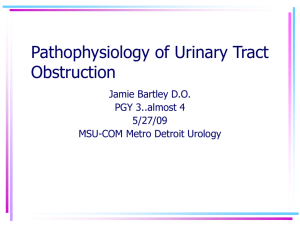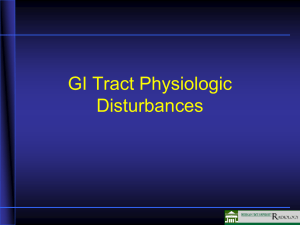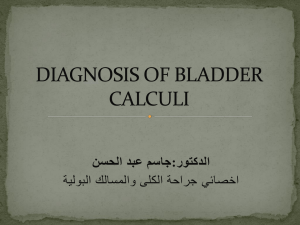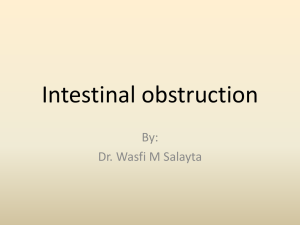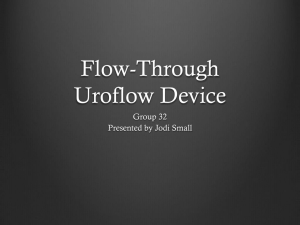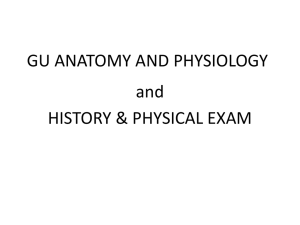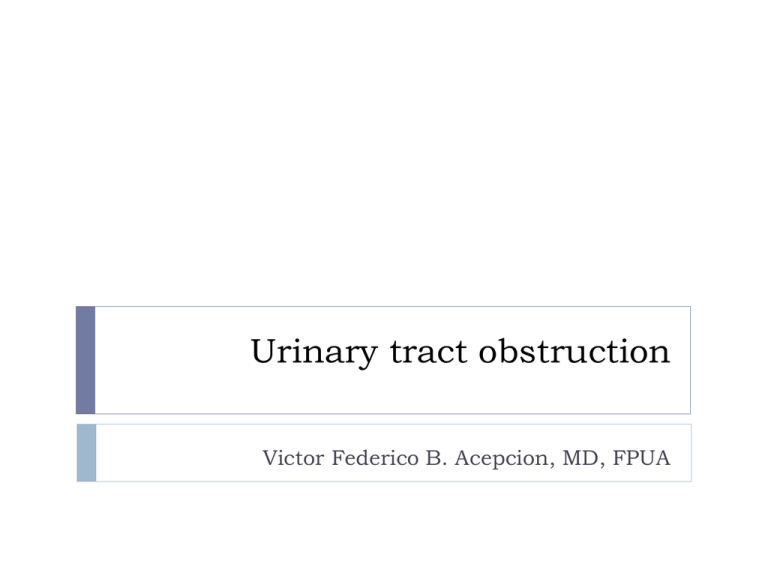
Urinary tract obstruction
Victor Federico B. Acepcion, MD, FPUA
The Kidney
Basic function:
formation of ultrafiltrate that is free of protein with
appropriate amount of water, electrolytes, and end products of
metabolic pathways to maintain homeostasis.
Remaining portion of UT
Eliminate and/or store urine
Urine production
Pressure gradient
from glomerulus to
Bowman capsule
Peristalsis of renal
pelvis and ureter
Effects of gravity
Urinary tract obstruction
•
•
Common cause of acute and chronic renal failure
Potentially curable form of kidney disease
Definition of terms
Obstructive uropathy
Obstructive nephropathy
Hydronephrosis
Objectives
Define urinary tract obstruction
Incidence
Etiology/pathophysiology
Clinical presentation
Diagnosis
Treatment and management
Pre-hospital/emergency department care
Incidence
•
Frequency
–
–
–
•
Sex
–
–
•
No data available in unselected populations
20-35% prevalence in large survey among elderly men
3.8% (adults); 2.0% (children) postmortem examinations
No gender difference until 20 years
Women 20-60; Men > 60
Age
–
Special considerations in pediatric patients
Etiology
Types of obstruction
Mechanical blockade
Intrinsic
extrinsic
Functional defects
Congenital
Common Mechanical Causes of Urinary
Tract Obstruction
Ureter
Bladder
Outlet
Urethra
Bladder neck
obstruction
Posterior
urethral valves
CONGENITAL
Ureteropelvic
junction
narrowing or
obstruction
Ureterovesical Ureterocele
junction
narrowing or
obstruction
and reflux
Ureterocele
Damage to S2- Stricture
4
Retrocaval
ureter
VUR
Anterior
urethral valves
Meatal
stenosis
VUR
Phimosis
Ureter
Bladder Outlet
Urethra
Acquired Intrinsic Defects
Calculi
Benign prostatic
hyperplasia
stricture
Inflammation
Cancer of the
prostate
tumor
Infection
Cancer of the
bladder
calculi
Trauma
Calculi
trauma
Sloughed
Papillae
Diabetic
neuropathy
phimosis
Tumor
Spinal cord
disease
Blood Clots
Anticholinergic
drugs and alpha
adrenergic
antagonists
Uric acid
crystals
Ureter
Bladder Outlet Urethra
Acquired Extrinsic Defects
Pregnant uterus
Carcinoma of
cervix, colon
Retroperitoneal
fibrosis
trauma
Aortic aneurysm
Uterine
leiomyomata
Carcinoma of
uterus, prostate,
bladder, colon,
rectum
lymphoma
Pelvic
inflammatory
disease,
endometriosis
Accidental
surgical ligation
trauma
Pathophysiology
Unilateral (UUO)?
Bilateral (BUO)?
Obstruction relieved or not?
Time
Global Renal Function Changes
Obstruction can affect hemodynamic variables and GFR
GFR= Kf(PGC-PT-PGC)
Kf- glomerular ultrafiltration coeffecient related to the surface
area and permeability of the capillary membrane
PGC- glomerular capillary pressure. Influenced by renal
plasma flow and the resistance of the afferent and efferent
arterioles
PT- Hydraulic pressure of fluid in the tubule
P- the oncotic pressure of the proteins in the glomerular
capillary and efferent arteriolar blood
RPF= (aortic pressure-renal venous pressure)
renal vascular resistance
Influences PGC
Constriction of the afferent arteriole will result in a decrease of PGC and
GFR
An increase in efferent arteriolar resistance will increase PGC
Triphasic pattern of UUO
Bilateral urinary obstruction (BUO)
•
•
•
•
No triphasic pattern
Modest increase in RBF after 90 min but between 90 min
to 7 hours, RBF is significantly lower than UUO.
Increase renal vascular resistance (RVR)
After 24 hours, low RBF, high RVR same as UUO
Bilateral urinary obstruction (BUO)
Ureteral pressure higher than in UUO
Effective RBF is markedly decreased after 48 hours
GFR is significantly decreased after 48 hours
Summary of UUO and BUO
Pathophysiology
Obstructive Uropathy
Obstructive Nephropathy
Pathophysiology of Bilateral Ureteral Obstruction
Hemodynamic Effects
Tubule Effects
Clinical Features
ureteral and tubular
pressures
pain
Acute
Renal Blood Flow
GFR
Medullary Blood Flow
azotemia
reabsorption of Na,
urea, water
Oliguria or anuria
Vasodilator PGs
Chronic
Renal Blood Flow
GFR
vasoconstrictor PGs
medullary osmolarity
azotemia
concentrating ability
hypertension
Structural damage;
parenchymal atrophy
renin-angiotensin pdn
transport fxn for Na,K,
H
ADH-insensitive polyuria
Hyperkalemic,
hyperchloremic acidosis
Pathophysiology of Bilateral Ureteral Obstruction
Release of Obstruction
Slow in GFR (variable)
Tubular pressure
solute load per nephron
(urea, NaCl)
Natriuretic factors present
Postobstructive diuresis
Potential for volume
depletion and electrolyte
imbalance due to losses of
Na, K, PO4, Mg and water
Consequences of urinary tract obstruction
•
Reduced glomerular filtration rate
•
Reduced renal blood flow (after initial rise)
•
Impaired renal concentrating ability
•
Impaired distal tubular function
•
•
Nephrogenic diabetes insipidus
•
Renal salt wasting
•
Renal tubular acidosis
•
Impaired potassium concentration
Postobstructive diuresis
Consequences of urinary tract obstruction
Progressive and permanent changes to the kidney occur
Tubulointerstitial fibrosis
Tubular atrophy and apoptosis
Interstitial inflammation
Diagnosis
•
History
–
–
–
–
–
–
–
Pain, renal colic
Inability to void effectively
Alteration in pattern of micturition (anuria, polyuria, nocturia)
Recurrent UTI
New-onset or poorly controlled hypertension
Polycythemia
Recent gynecologic or abdominal surgery
•
History
–
–
Medication history
• Antihistamines, antipsychotics, antidepressants
• Ethylene glycol, indinavir, methotrexate, phenylbutazone, or
sulfunamides
• Methysergide or other natural-occurring ergotamines
Occupational exposure history
• Textile manufacturers, shipyard workers, roofers or asbestos
miners (retroperitoneal fibrosis)
• Textile workers, rubber manufacturing workers, leather
workers, painters, hairdressers, drill press workers (bladder
cancer)
Physical Examination
Signs of dehydration and intravascular volume depletion
Peripheral edema, hypertension, signs of congestive heart
failure
Palpable kidney or bladder
Enlargement of pelvic organs (eg. Prostate, uterus)
Examination of external urethra for phimosis, meatal stenosis
Normal kidney
Treatment and management
Prehospital Care
Pulmonary edema
Salt and water retention
hypovolemia
Treatment and management
Emergency department care
Investigate and begin treatment of potentially life-threatening
complications
Pulmonary edema
Hypovolemia
Urosepsis
Hyperkalemia
Treatment and management
•
–
Overriding goal of treatment: reestablishment of urinary flow
Transurethral bladder catheterization
•
•
Diagnostic and therapeutic
No urine output = investigate upper tract
Treatment and management
Large PVR = obstruction below the bladder
Fractionating urine removal (?)
Hematuria and bladder spasm
Christensen, et al. concluded that fractionating urine removal in bladder
obstruction is unjustified
Gould, et al. : hematuria correlated strongly with degree of bladder wall damage
prior to relief of obstruction and not with rate of bladder emptying
Urine should be drained completely and rapidly from an obstructed
bladder
Prolonged urine stasis only predisposes to UTI, urosepsis and renal
failure
Treatment and management
Calculi – most common causes of unilateral ureteral
obstruction
90% pass spontaneously (calculi <5.0-7.0 mm)
Surgical drainage necessary if with unrelenting pain, UTI,
persistent obstruction, progressive loss of renal function
Position of stone determines preferred method of removal
Treatment and management
Bilateral ureteral obstruction – always asymmetric
process
mid to proximal ureter – percutaneous nephrostomy
Distal obstruction – cystoscopic placement of ureteral stent
Intrarenal obstruction secondary to crystals or protein casts hydration
Treatment and management
Consultations
UROLOGIST – when transurethral catheter cannot provide
adequate drainage and surgical drainage and removal of
obstruction is necessary
NEPHROLOGIST – when emergent hemodialysis is necessary
Treatment and management
Further Inpatient care
Decision to admit depends on the need for invasive surgical
drainage procedure and complications of obstruction
Replacement of electrolyte disturbances
Further Outpatient care
Depending on specific complications of obstruction, relief of
bladder neck obstruction requires prompt follow-up care with
a urologist for definitive therapy.
Prognosis
With relief of obstruction
Reversible or irreversible damage?
Obstruction NOT relieved
Complete or incomplete?
Bilateral or unilateral?
Presence or absence of infection
Summary
UTO is an important urologic disorder and a common
cause of acute and chronic renal failure
Multiple causes, high clinical suspicion and acumen
necessary
UTO is a potentially reversible process
Prompt recognition
Prompt treatment
Prompt consultation/referral
Thank You



